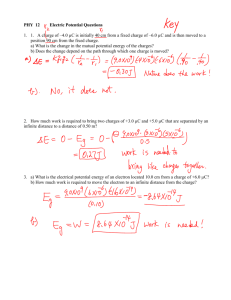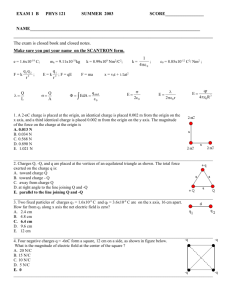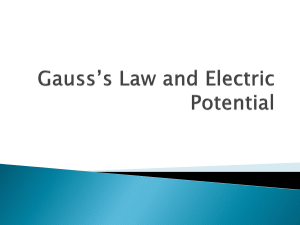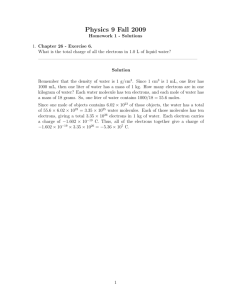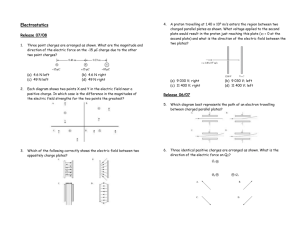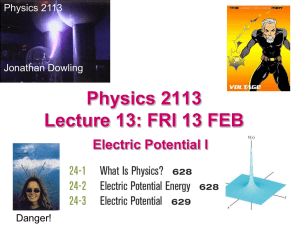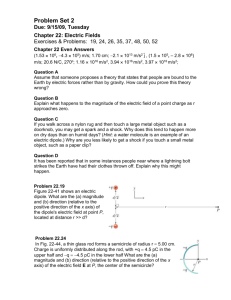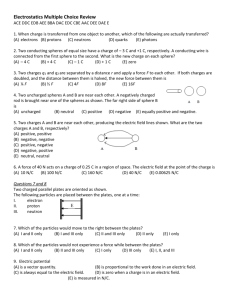Chapter24
advertisement
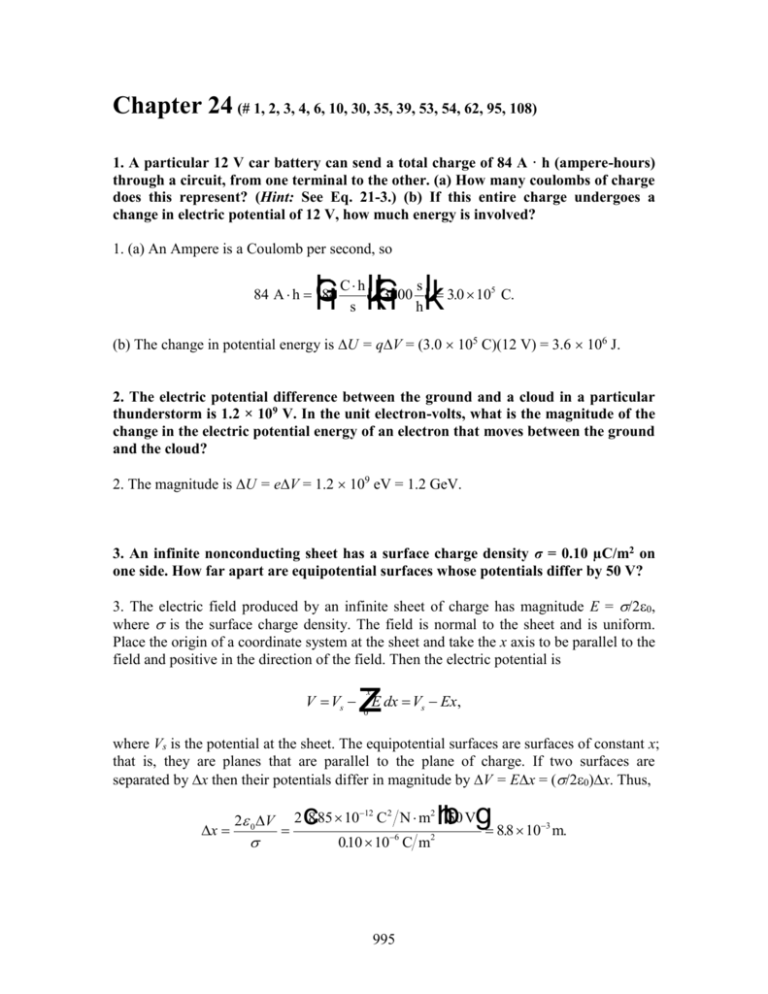
Chapter 24 (# 1, 2, 3, 4, 6, 10, 30, 35, 39, 53, 54, 62, 95, 108) 1. A particular 12 V car battery can send a total charge of 84 A · h (ampere-hours) through a circuit, from one terminal to the other. (a) How many coulombs of charge does this represent? (Hint: See Eq. 21-3.) (b) If this entire charge undergoes a change in electric potential of 12 V, how much energy is involved? 1. (a) An Ampere is a Coulomb per second, so C h IF sI F 3600 J 3.0 10 G J G H s KH h K 84 A h 84 5 C. (b) The change in potential energy is U = qV = (3.0 105 C)(12 V) = 3.6 106 J. 2. The electric potential difference between the ground and a cloud in a particular thunderstorm is 1.2 × 109 V. In the unit electron-volts, what is the magnitude of the change in the electric potential energy of an electron that moves between the ground and the cloud? 2. The magnitude is U = eV = 1.2 109 eV = 1.2 GeV. 3. An infinite nonconducting sheet has a surface charge density σ = 0.10 µC/m2 on one side. How far apart are equipotential surfaces whose potentials differ by 50 V? 3. The electric field produced by an infinite sheet of charge has magnitude E = /20, where is the surface charge density. The field is normal to the sheet and is uniform. Place the origin of a coordinate system at the sheet and take the x axis to be parallel to the field and positive in the direction of the field. Then the electric potential is V Vs z x 0 E dx Vs Ex, where Vs is the potential at the sheet. The equipotential surfaces are surfaces of constant x; that is, they are planes that are parallel to the plane of charge. If two surfaces are separated by x then their potentials differ in magnitude by V = Ex = (/20)x. Thus, x 2 0 V c hb g 8.8 10 2 8.85 1012 C2 N m2 50 V 6 010 . 10 C m 995 2 3 m. 996 CHAPTER 24 4. When an electron moves from A to B along an electric field line in Fig. 24-29, the electric field does 3.94 × 10-19 J of work on it. What are the electric potential differences (a) VB – VA, (b) VC – VA, and (c) VC – VB? 4. (a) VB – VA = U/q = –W/(–e) = – (3.94 10–19 J)/(–1.60 10–19 C) = 2.46 V. (b) VC – VA = VB – VA = 2.46 V. (c) VC – VB = 0 (Since C and B are on the same equipotential line). 6. A graph of the x component of the electric field as a function of x in a region of space is shown in Fig. 24-30. The y and z components of the electric field are zero in this region. If the electric potential at the origin is 10 V, (a) what is the electric potential at x = 2.0 m, (b) what is the greatest positive value of the electric potential for points on the x axis for which 0 ≤ x ≤ 6.0 m, and (c) for what value of x is the electric potential zero? 6. (a) By Eq. 24-18, the change in potential is the negative of the “area” under the curve. Thus, using the area-of-a-triangle formula, we have V 10 z x 2 0 1 E ds 2 20 2 bgb g which yields V = 30 V. z (b) For any region within 0 x 3 m, E ds is positive, but for any region for which x > 3 m it is negative. Therefore, V = Vmax occurs at x = 3 m. V 10 z x 3 0 1 E ds 3 20 2 bgb g which yields Vmax = 40 V. (c) In view of our result in part (b), we see that now (to find V = 0) we are looking for some X > 3 m such that the “area” from x = 3 m to x = X is 40 V. Using the formula for a triangle (3 < x < 4) and a rectangle (4 < x < X), we require bgb gb gb g 1 1 20 X 4 20 40 . 2 Therefore, X = 5.5 m. 997 10. As a space shuttle moves through the dilute ionized gas of Earth’s ionosphere, the shuttle’s potential is typically changed by -1.0 V during one revolution. assuming the shuttle is a sphere of radius 10 m, estimate the amount of charge it collects. 10. The charge is q 4 0 RV (10m) (1.0V) 8.99 10 N m 9 2 /C 2 1.1109 C. 30. Two large parallel metal plates are 1.5 cm apart and have charges of equal magnitudes but opposite signs on their facing surfaces. Take the potential of the negative plate to be zero. If the potential halfway between the plates is then +5.0 V, what is the electric field in the region between the plates? 30. The magnitude of the electric field is given by | E | V 2(5.0V) 6.7 102 V m. x 0.015m At any point in the region between the plates, E points away from the positively charged plate, directly towards the negatively charged one. 35. An electron is placed in an xy plane where the electric potential depends on x and y as shown in Fig. 24-45 (the potential does not depend on z). In unit-vector notation, what is the electric force on the electron? 35. The electric field (along some axis) is the (negative of the) derivative of the potential V with respect to the corresponding coordinate. In this case, the derivatives can be read off of the graphs as slopes (since the graphs are of straight lines). Thus, dV 500 V Ex = – d x = – 0.20 m = 2500 V/m = 2500 N/C dV 300 V Ey = – d y = – 0.30 m = –1000 V/m = –1000 N/C . These components imply the electric field has a magnitude of 2693 N/C and a direction of –21.8º (with respect to the positive x axis). The force on the electron is given by F qE where q = –e. The minus sign associated with the value of q has the implication that F points in the opposite direction from E (which is to say that its angle is found by adding 180º to that of E ). With e = 1.60 × 10–19 C, we obtain 998 CHAPTER 24 ˆ (4.0 10 16 N)iˆ (1.60 1016 N)jˆ . F (1.60 1019 C)[(2500 N/C)iˆ (1000 N/C)j] 39. (a) What is the electric potential energy of two electrons separated by 2.00 nm? (b) If the separation increases, does the potential energy increase or decrease? 39. (a) We use Eq. 24-43 with q1 = q2 = –e and r = 2.00 nm: d i 8.99 109 NCm2 (160 . 1019 C) 2 q1q2 e2 U k k 115 . 1019 J. 9 r r 2.00 10 m 2 (b) Since U > 0 and U r–1 the potential energy U decreases as r increases. 53. What is the excess charge on a conducting sphere of radius r = 0.15 m if the potential of the sphere is 1500 V and V = 0 at infinity? 53. If the electric potential is zero at infinity, then the potential at the surface of the sphere is given by V = q/40r, where q is the charge on the sphere and r is its radius. Thus q 4 rV . mg b015 b1500 Vg 2.5 10 8.99 10 N m C 9 2 2 8 C. 54. A hollow metal sphere has a potential of +400 V with respect to ground (defined to be at V = 0) and a charge of 5.0 × 10-9 C. Find the electric potential at the center of the sphere. 54. Since the electric potential throughout the entire conductor is a constant, the electric potential at its center is also +400 V. 62. Proton in a well. Figure 24-55 shows electric potential V along an x axis. A proton is to be released at x = 3.5 cm with initial kinetic energy 4.00 eV. (a) If it is initially moving in the negative direction of the axis, does it reach a turning point (if so, what is the x coordinate of that point) or does it escape from the plotted region (if so, what is its speed at x = 0)? (b) If it is initially moving in the positive direction of the axis, does it reach a turning point (if so, what is the x coordinate of that point) or does it escape from the plotted region (if so, what is its speed at x = 6.0 cm)? What are the (c) magnitude F and (d) direction (positive or negative direction of the x axis) of the electric force on the proton if the proton moves just to the left of x = 3.0 cm? What are (e) F and (f) the direction if the proton moves just to the right of x = 5.0 cm? 999 62. (a) When the proton is released, its energy is K + U = 4.0 eV + 3.0 eV (the latter value is inferred from the graph). This implies that if we draw a horizontal line at the 7.0 Volt “height” in the graph and find where it intersects the voltage plot, then we can determine the turning point. Interpolating in the region between 1.0 cm and 3.0 cm, we find the turning point is at roughly x = 1.7 cm. (b) There is no turning point towards the right, so the speed there is nonzero, and is given by energy conservation: v= 2(7.0 eV) = m 2(7.0 eV)(1.6 x 10-19 J/eV) = 20 km/s. 1.67 x 10-27 kg (c) The electric field at any point P is the (negative of the) slope of the voltage graph evaluated at P. Once we know the electric field, the force on the proton follows immediately from F = q E , where q = +e for the proton. In the region just to the left of x = 3.0 cm, the field is E = (+300 V/m) î and the force is F = +4.8 1017 N. (d) The force F points in the +x direction, as the electric field E . (e) In the region just to the right of x = 5.0 cm, the field is E =(–200 V/m) î and the magnitude of the force is F = 3.2 1017 N. (f) The force F points in the x direction, as the electric field E . 95. A decade before Einstein published his theory of relativity, J. J. Thomson proposed that the electron might consist of small parts and attributed the electron’s mass m to the electric potential energy of the interaction of the parts. Furthermore, he suggested that the energy equals mc2, where c is the speed of light. Make a rough estimate of the electron mass in the following way: Assume the electron is composed of three identical parts that are brought in from infinity and placed at the vertices of an equilateral triangle having sides equal to the classical radius of the electron, 2.82 × 10-15 m. (a) Find the total electric potential energy of this arrangement. (b) Divide by c2 and compare your result with the accepted electron mass. (The result improves if more parts are assumed.) 95. (a) The total electric potential energy consists of three equal terms: U= q1 q2 q2 q3 q1 q3 + + 4o r 4o r 4o r e where q1 = q2 = q3 = 3 , and r as given in the problem. The result is U = 2.72 1014 J. 1000 CHAPTER 24 (b) Dividing by the square of the speed of light (roughly 3.0 108 m/s), we obtain a value in kilograms (about a third of the correct electron mass value): 3.02 1031 kg. 108. In a Millikan’s oil-drop experiment (Section 22-8), a uniform electric field of 1.92 × 105 N/C is maintained in the region between two plates separated by 1.50 cm. Find the potential difference between the plates. 108. The potential difference is V = Es = (1.92 105 N/C)(0.0150 m) = 2.90 103 V.


